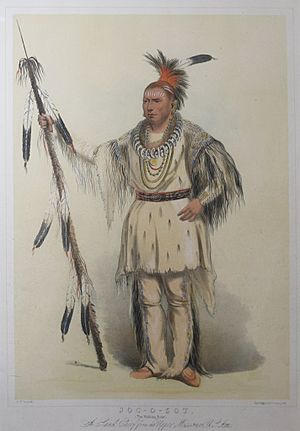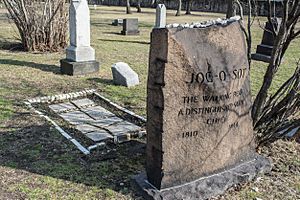Joc-O-Sot facts for kids

Joc-O-Sot, also known as Walking Bear, was a Native American from the Meskwaki tribe. He lived from about 1810 to 1844. He fought in the Black Hawk War and was injured. After the war, he led hunting and fishing trips near Cleveland, Ohio. Later, he joined a theater group. He became very famous in the Eastern United States and Europe by showing Native American life on stage. His old war injuries made him sick. While on a goodwill tour, he became very ill and died in Cleveland. People have been interested in his grave ever since he died, both because of his interesting life and some local stories.
Contents
Joc-O-Sot's Life Story
Early Life and War Service
Joc-O-Sot was born around 1810. He belonged to the Meskwaki tribe, whose home was in what is now Iowa. His father's name was Katuchasha. His father earned the special name "The Bear" because of his brave actions in wars against the Osage Nation.
The Meskwaki tribe joined with the Sauk people during the Black Hawk War. Even though Joc-O-Sot tried to prevent this war, he fought in it as a Meskwaki leader. He suffered serious injuries during the fighting. A few years after the war, he moved to the Cleveland, Ohio area. There, he led trips for fishing and hunting. While in Cleveland, he became good friends with Dr. Horace Ackley.
Becoming a Performer
Through Dr. Ackley, Joc-O-Sot met Dan Marble, a theater performer. To help his tribe financially, Joc-O-Sot joined Marble's theater group. In the shows, he acted out scenes from Native American culture. His first show was in Cincinnati and was very popular. The act then toured across the Eastern United States.
In 1844, Dan Marble encouraged Joc-O-Sot to join a company led by William Vincent Wallace. This group planned to tour England. Joc-O-Sot's performances in England were very popular. People loved his traditional clothing. He was even asked to perform for the Royal family. People noted his intelligence, noble manner, and politeness. Queen Victoria was very impressed by him. She asked for an official portrait of Joc-O-Sot to be made by Day and Hague. This picture is now lost.
Illness and Final Journey
Joc-O-Sot did not stay in England for long. He became ill, likely with tuberculosis. He decided to return to the United States on his own. His plan was to go home near Fort Leavenworth, Missouri. He stopped in Washington, D.C., to meet with President John Tyler on behalf of his people. Then, he went to Montreal, Canada, for the same reason. He made several friendly stops along the way.
He walked as far as Buffalo, New York. At that point, his health was too poor for him to walk further. He was convinced to take a boat west. However, his illness forced him to stop in Cleveland. It seems the theater company did not pay him well. By the time he reached Cleveland, he had no money. A doctor in Cleveland diagnosed him with "quick consumption," which meant he was very sick. A local coal businessman, John G. Stockley, gave him a place to stay in his office. Joc-O-Sot likely knew he was dying. Some of his last words were, "Joc-O-Sot go up."
Joc-O-Sot's Death and Burial
Joc-O-Sot died shortly after arriving in Cleveland, on September 3, 1844. Dr. Ackley, John Stockley, and other friends arranged his funeral and burial. A funeral service was held the day after his death at the Second Presbyterian Church. He was then buried at Erie Street Cemetery in downtown Cleveland. This burial was meant to honor both Joc-O-Sot and all Native American people. Soon after news of his death spread, he was chosen as chief of the Sauk tribe.
A sandstone gravestone was placed at his burial site. However, it incorrectly states that he died in August, not September. It is believed that his body was later moved for medical research. Cleveland city records from 1882 confirm his body was removed. In 1877, the tombstone broke into three pieces when a heavy tree limb fell on it. It was repaired with metal rivets, but by 1884, it was broken again. This original tombstone was further damaged by vandals in 1907.
Was Joc-O-Sot a Chief?
There is some debate about whether Joc-O-Sot was truly a chief. Orlando J. Hodge thought it was possible because Joc-O-Sot saw himself as a chief and was called one. However, Hodge also noted that Joc-O-Sot was young and had not achieved many great things in battle.
The granddaughter of Oghema Niagara claimed that Joc-O-Sot was one of the "greatest chiefs" of his time. She said that local tribes honored him, and she visited his grave every year. It is known that he was chosen as a chief after he died.
Stories About His Grave
Some local stories are told about Joc-O-Sot's grave. The Cleveland Paranormal Society believes the broken tombstone shows Joc-O-Sot's sadness about not being able to return to his tribe. Another local story says that people who damaged the tombstone were supernaturally punished with madness. This was supposedly due to a curse placed by Oghema Niagara (also known as Chief Thunderwater).
Chief Niagara even said that a "terrible disaster" would happen to Cleveland if Joc-O-Sot's burial place was disturbed again. It is said that bad luck affected several different builders who wanted to move the graves for money. For many years, three stalks of corn would grow next to Joc-O-Sot's grave. People believed this was because a member of the Sauk tribe visited regularly.
Some superstitious people have even blamed Joc-O-Sot's supposed ghost for losses by the Cleveland Indians baseball team. Because of this, people have placed small gifts on his grave. They hope these gifts will stop him from interfering with game days.


